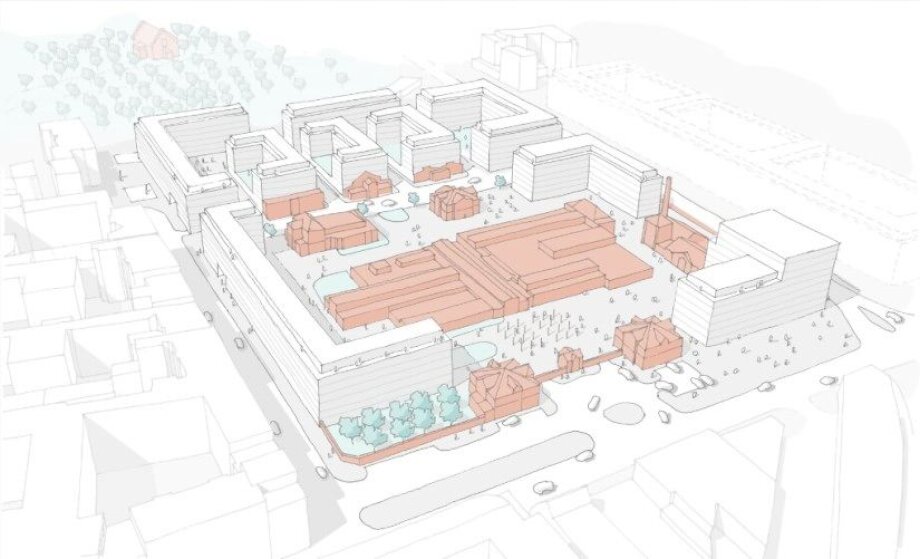Investors Liebrecht & wooD and BBI Development have officially opened a publicly accessible 4,000-sqm square that lies at the center of their Centrum Praskie Koneser mixed-use project in the Praga Północ district of Warsaw. The ongoing scheme, which will result in the revitalization of five hectares of post-industrial land that previously housed a vodka distillery is now nearing completion, with new event, office, retail, restaurant and residential areas scheduled to be delivered by the end of this year.
Google’s Campus Warsaw, several office and residential buildings, an event center and the Polish Vodka Museum have already been open for some time. Marriott International’s 141-room Moxy Warsaw Praga hotel will welcome its first guests in late 2018 or early 2019. In total, the multi-phase development will comprise 88,000 sqm of space, including 25,500 sqm of office space and 21,800 sqm of retail and service areas. The residential part of the investment, which BBI Development is developing on its own, will feature around 350 units.
Centrum Praskie Koneser is just one of a number of big mixed-use projects of this kind now under construction or in the pipeline in Poland. Also in Warsaw, Capital Park is working on its ArtN scheme that will regenerate a major post-industrial site located in the Wola district. A combined more than 64,000 sqm of usable space – including 40,000 sqm of office space and 24,000 sqm of retail, entertainment and cultural areas – will be built there. The location previously housed a metalwork factory dating back to the 19th century.
For their part, Tristan Capital Partners and White Star Real Estate are developing their Elektrownia Powiśle investment in the downtown of the city, which will entail the renovation of a former power plant site and will include office, retail, residential and hotel space. In Łódź, Virako is building its Monopolis on the site of a former vodka distillery with the project expected to include office, retail, cultural and recreational areas. Vastint is planning major mixed-use schemes in cities including Wrocław and Gdynia (read interview here).

URBAN PLANNING TREND
Several factors are at play when it comes to the growing popularity of large-scale mixed-use projects that result in the revitalization of entire historic or/and post-industrial neighborhoods of Polish cities. On the one hand, there is the general shortage of vacant plots in city centers. Jan Szulborski from the consulting and research department of Cushman & Wakefield noted that the boom which we have been seeing in all commercial property market sectors in recent years has led to a depletion of the pool of attractive sites.
“As the market competition intensifies, the supply of land gets more and more limited and the expectations of tenants change, developers are increasingly turning towards areas that used to be an important element of the urban fabric but have now lost their original function,” he said. On the other hand, mixing building functions is a major feature of modern urban planning. There is currently a move away from designing neighborhoods dominated by one particular function, Szulborski added.
He said that the changes currently taking place in Warsaw’s Służewiec area are a case in point. Once an industrial neighborhood, Służewiec has become the biggest office hub in Poland, but is now also seeing the development of many new residential and hotel schemes. Developers see the potential for synergy that comes with combining several various functions within one project. However, Szulborski claimed that coming up with the right mix of functions is also one of the main challenges for investors launching mixed-use developments.
Of a similar opinion was Bolesław Kołodziejczyk, head of research and advisory at Cresa Poland, who pointed out that the expectations of the end users of the particular functions are often divergent. For instance, apartment owners will expect silence in the afternoons, while the owners of stores and restaurants will want to maximize footfall to make their businesses successful. Reconciling such expectations is difficult but doable through proper architectural solutions.

WORTH THE EFFORT
In general, mixed-use developments require from developers much more know-how and experience than single-use investments. Also, they involve significant capital expenditure, which is a major barrier to entry, Kołodziejczyk noted. Crucially, the renovation of historic properties that are often part of such projects is technically challenging and requires close cooperation with the heritage conservation officer. Obtaining all the necessary administrative permits tends to be a lengthy process.
“Such projects are extremely demanding for all parties involved. Every building and every interior element must be completed with the utmost care,” admitted Magdalena Bartkiewicz-Podoba, general manager at Liebrecht & wooD Poland. Kinga Nowakowska, operational director and management board member at Capital Park, revealed that it took the company almost ten years to prepare ArtN. It also took 12 tomes of technical documentation to meticulously describe the entire planned renovation process.
Nevertheless, Nowakowska stressed that the time spent on preparing the investment was not wasted and the work put into it during its initial phase is currently bearing fruit as the unique nature of the development is attracting business partners, including tenants. “It is in the DNA of our company to create places with a history, a soul and a certain social capital that a project brings with itself. That capital is the value which makes an investment timeless and attractive for people of different ages and with different needs,” she said.
Experts, too, stress that the final effect is usually worth the effort. Mixed-use projects are appreciated by tenants from almost all segments of the real estate market, including the office sector, in which the needs of the employee are playing a more and more important role. Retailers want to be close to buyers and residents enjoy easy access to stores. From the perspective of hotel chains, proximity to a rich restaurant and retail offering is a bonus that comes at no additional cost. “Such projects have a future,” Kołodziejczyk maintained.




















